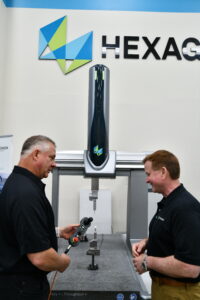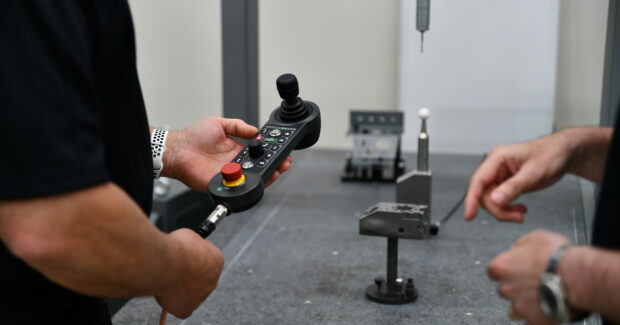How Manufacturers are Using AI, and Training Workers for the Future
With an AI-powered tool, a worker presses a few buttons, and the machine tool can run 90%-to-95% of the process itself. The focus is on integrating more AI-empowered technology into the manufacturing process.
Posted: August 22, 2024

The manufacturing industry is experiencing a serious labor gap (studies show a manufacturing jobs shortage in 48 out of 50 states) — and it is very difficult today to find qualified machinists and experienced assembly technicians. To address this need, organizations are creating smarter technology and tools that leverage AI to collect and analyze data to optimize manufacturing processes. This allows the users to handle increased complexity and for the AI to perform more of the heavy lifting, simplifying the role of the factory team.
For example, at Hexagon we have invested in creating AI, digital twin and simulation technology that optimizes training and upskilling on the factory floor. This is crucial to our customers, due to the massive need in manufacturing for rapid onboarding, training and constant upskilling.
Over the past few years, we’ve seen a stark increase in interest and investment in using AI to improve productivity in the factory.
One example of this is within Hexagon’s own factories, which also serve as a proving ground for the company’s manufacturing technologies. Adopting AI optimizes production planning and manufacturing workflows. Hexagon has created an AI-based Manufacturing Execution System (MES), which keeps track of every worker’s skill set and capabilities based on a cross-training program. The AI system then directs where to place workers, based on their skills, while considering capacity planning, lead times, work attendance, etc. The system provides unparalleled visibility to the overall production operation, making it easier to proactively determine where problems are likely to arise.
If somebody calls out sick, or if there is a part shortage, the system automatically adapts to that and changes the production plan based on available resources. It can also be used for planning by simulating different scenarios, such as adding labor or overtime. This AI empowered tool simulates how different actions will impact overall production plans and deliveries. AI is helping better leverage resources on the factory floor, driving efficiency improvements and directing cross-training and upskilling efforts by identifying which skills workers need more focus on.
How AI is Being Used in Manufacturing
At a high level, AI is being used to make factory workers’ jobs easier, so manufacturing processes can therefore be more efficient. Some examples of how this is coming to life:
- Simulation tools for training: A lot of the machines used in manufacturing and metrology are incredibly expensive. An inexperienced user can easily damage a machine worth hundreds of thousands of dollars or produce results leading to scrapped parts and increased costs. Additionally, if a machine is used inappropriately, it can be incredibly dangerous for the user.
Because of the tough hiring landscape, there are a lot of inexperienced users, so training is essential. However, manufacturers don’t want to take these machines offline during heavy production periods to focus on training. As a solution, manufacturers are starting to use simulations and digital twins to bridge the gap and better prepare staff for the demands of the factory. Products such as HxGN Machine Trainer deliver on this and as a bonus, can use AI to simulate multiple types of CNC and CMM machine interfaces. This allows companies to train several machine interfaces on a single virtual trainer.
- Infusing more intelligence into machine tools: Machine learning is coming into play to make more intelligent machine tools, so workers aren’t required to have quite the same level of qualifications and experience that was needed in the past. For example, with CNC machining, new programming systems using AI can now be used to make many of the decisions and predict the best way to perform a task (based on the capability of the machine and past use cases). The solution can automatically create strategies based on what was executed previously, so the person operating the tool will benefit from all the acquired knowledge collected from the historical use of the tool, which is a huge leg up when it comes to empowering the workforce.
- AI for quality control: Typically, inspection programs need to be developed by programmers; however, with today’s embedded AI technology, inspection routines can be automatically generated. This decreases the need within manufacturing for highly experienced programmers. For example, when inspecting parts today, a person can load up a design model (CAD) into the measurement software and have it automatically create the program, only needing the worker to hit go.
- Safety: We’re using scanners installed in our factories in Germany that use AI to essentially “hunt” for things that are weird and out of place. The scanning systems search for heat signatures that seem strange — capturing the data, interpreting it and acting on it. So, for example, if it sees a heat signature that isn’t moving and is lying on the ground during the night shift, it will interpret that somebody may have fallen and raise the alarm for quick intervention.
In automated production lines, sensors that can determine if machines are moving off track so the line can be shut down before damage occurs. This combination of sensors, software and AI is being used to keep factory workers safer — especially during overnight shifts when fewer people are in the building.
These are just some of the ways AI is being used in manufacturing. AI-powered tools are in high demand, as they can shorten the amount of time it takes to onboard and train employees to efficiently perform their jobs. Everyone in our industry is seeking “lights out manufacturing” where the machines can run themselves (or at least with less direct oversight). We aren’t there just yet as a lot of this technology is still cutting edge, and a lot of the AI capabilities are just emerging.
Training Manufacturing Workers for the Future
With the newest generation of “Snapchat” engineers and workers, training on the use of AI is not especially challenging. This new workforce expects smarter tools from the get-go. Today’s AI-powered tools are becoming simpler to use. The real challenge is to integrate these tools throughout the factory to leverage the technology in making jobs easier. This simplification allows for quicker onboarding and upskilling, allowing companies to overcome the labor shortage.
Machinist skills are still among the most in-demand. Workers need familiarity and experience with these machine tools to perform their job well. In modern factories, workers now need more familiarity with software (as machining continues to become less manual).
Looking ahead, manufacturing workers will need to increase their familiarity with software and simulations. Manufacturing used to be very physical, an “elbow grease” kind of job. Now it’s starting to require more interaction with devices that are software and AR/VR focused.
We anticipate seeing more AR/VR usage — especially to support training — in the future.
We aren’t seeing a lot of outsourcing around training related to AI — much of the focus is on getting technologies into the factories that are more intelligent. With an AI-powered tool, a worker can just press a few buttons and the machine tool can run 90%-to-95% of the process itself. So, the focus is on getting more AI-empowered technology in the door and integrated into the manufacturing process.
Hexagon Manufacturing Intelligence

















